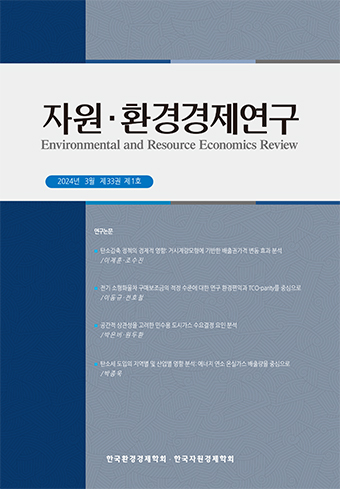Research Paper
Abstract
References
Information
We analyze the learning-by-doing effects of the allowance pricing system on the Korea's emission trading scheme. The price of allowance (Korean Allowance Unit) is influenced differently by internal market factors and economic conditions variables in the first (January 2015 to June 2016 ) and the second commitment year(January 2016 to June 2017). The prices and transaction volumes of complementary credits (KCU and KOC) as well as economic conditions variables (such as call rate, exchange rate, stock price) are statistically significant only for the second commitment year. Thus, the learning-by-doing effect makes the market participation decision on K-ETS market more efficient in the second commitment year, adopting the previous experience and knowledge in the K-ETS market. The factors estimated significantly in both commitment periods include the institutional binary variable for requiring the submission of the emissions verification reports issued both on February and March.
2015년 1월부터 시행된 시장기반 온실가스감축수단인 한국 탄소배출권시장의 가격결정체계와 2차 이행연도로의 진행과정에서 발생하는 학습효과에 대하여 고찰한다. 분석결과, 1차와 2차 이행연도 간에 차이점이 존재하는 것으로 추정되었다. 장내요인의 경우, 2차 이행연도에서는 1차 이행연도에서 추정되지 않았던 KCU와 KOC 가격·거래량 변수가 유의하게 추정되었다. 또한, 대내외 경제상황 변수의 경우, 1차 이행연도에서는 모든 변수들이 유의하지 않았으나, 2차 이행연도에서는 금리, 환율, 주가변수에서 통계적 유의성이 확보되었다. 이는, 1차에서 2차 이행연도로 진행하면서 시장운영자인 정부와 시장참여자인 기업들이 1차 이행연도에서의 경험과 지식을 바탕으로 2차 이행연도에서의 배출권 관련 의사결정을 보다 효율화하는 학습효과에 기인한다. 한편, 중점분석대상인 KAU15와 KAU16 가격에 대하여 공통적으로 유의미한 설명변수로는 각 배출권의 이행연도 이듬해 2월과 3월의 명세서 작성 및 제출에 대한 제도이항변수가 존재하였다.
- 관계부처 합동, 「국가 온실가스 감축목표 달성을 위한 로드맵」, 녹색성장위원회 심의(1.23), 국무회의 보고(1.28), 2014.
- 관계부처 합동, 「배출권 거래시장 안정화 방안」, 2017.4.5., 2017a.
- 관계부처 합동, 「온실가스 배출권거래제 제1차 계획기간 제3차 이행연도 배출권 할당계획 변경(안)」, 2017.1., 2017b.
- 관계부처 합동, 「온실가스 배출권거래제 제2차 계획기간(2018년~2020년) 국가 배출권 할당계획(안)」, 2017.12., 2017c.
- 기획재정부, 「제2차 배출권거래제 기본계획(안)」, 2017.1., 2017.
- 김규림, “국내 탄소배출권 거래 현황”, 자본시장연구원 자본시장 Weekly Zoom-in, 2016-01호, 2016.
- 김규림‧유종민‧김지태, “배출권 시장안정화 정책수립 방향 및 쟁점”, 환경정책, 제24권 제2호, 2016, pp. 189~210.
- 문진영, “배출권거래제에서의 의사결정 순서와 불확실성 영향 분석”, 자원‧환경경제연구, 제25권 제3호, 2016, pp. 403~419.
- 박순철‧조용성, “탄소배출권 EUA와 sCER의 가격 차이 패턴 및 스프레드(spread) 결정 요인 분석”, 자원‧환경경제연구, 제22권 제4호, 2013, pp. 759~784.
- 박순철‧조용성, “한국 탄소배출권 거래시장 일물일가 검정 및 가격 결정요인 분석”, 한국환경경제학회 2017 하계학술대회 발표논문, 2017.
- 부기덕‧정기호, “SVECM 모형을 이용한 탄소배출권 가격 연구”, 자원환경경제연구, 제 20권 제3호, 2011, pp. 531~564.
- 오주홍, “국내외 탄소시장 전망 및 배출권 거래 전략”, 한국기후변화대응연구센터 탄소배출권사업단 전문가 리포트, 2016.
- 온실가스종합정보센터, 「1차 계획기간(2015-2017) 업종별 할당량‧배출량 현황」, 2017.8.기준, 2017.
- 온실가스종합정보센터, 「제1차 계획기간 제1‧2차 이행연도 배출권거래제 운영결과보고서」, 2018.
- 유종민‧유재형‧김지태‧이종은, “한국 온실가스 감축정책의 효과: 배출권거래제 전후 비교”, 환경정책, 제25권 제2호, 2017, pp. 231~247.
- 임성수‧양승룡, “CDM 사업배출권의 가격결정요인 분석”, 자원‧환경경제연구, 제17권 제4호, 2008, pp. 691~717.
- 장현숙‧이인숙, 「해외 온실가스 배출권거래제 전망과 우리의 대응-현지 진출 한국업체 사례를 중심으로」, 한국무역협회 국제무역연구원 Trade focus, 제14권 제45호, 2015.
- 한국거래소, 「KRX 배출권시장 안내」, 2017.
- 한국거래소‧주한유럽대표부‧한국환경공단, 「한-EU 배출권거래제 협력사업 - 배출권시장 발전을 위한 공동세미나」, 2017년 9월 13일 세미나자료, 2017.
- 한국환경공단, 「탄소시장 정보 뉴스레터 1~18호」2017.1.~2017.9., 2017.
- 한국환경정책‧평가연구원, 「배출권거래제 현황 및 이슈」, KEI포커스, 제3권 제2호, 2015.
- 홍원경‧박호정, “기간구조에 따른 국내 배출권의 이행연도별 가격 분화”, 환경정책연구, 제14권 제3호, 2015, pp. 41~73.
- 홍이슬‧오형나‧홍종호, “EU-ETS 배출권 가격결정요인 분석: 과잉할당량을 중심으로”, 경제학연구, 제64권 제3호, 2016, pp. 91~123.
- 환경부, 「국가 배출권 할당계획-온실가스 배출권거래제 제1차 계획기간(2015년~2017년)」, 2014.9.11., 2014a.
- 환경부, 「온실가스 배출권거래제 제1차 계획기간(2015년~2017년) 국가 배출권 할당계획」, 2014.9.11., 2014b.
- 환경부‧한국거래소, “상쇄배출권 상장-배출권시장 거래물량 증가 기대”, 2015년 4월 6일 보도자료, 2015.
- Aatola, P., M. Ollikainen, and A. Toppinen, “Price determination in the EU ETS market: theory and econometric analysis with market fundamentals”, Energy Economics, Vol. 36, 2013, pp. 380~395.10.1016/j.eneco.2012.09.009
- Alberola, E., J. Chevaliier, and B. Cheze, “The EU emissions trading scheme: the effects of industrial production and CO2 emissions on European carbon price”, Economie Interationale, Vol. 4, 2009, pp. 93~125.
- Chevallier, J., “Carbon price drivers : an updated literature review”, International Journal of Applied Logistics, Vol. 4, No. 4, 2011, pp. 1~7.
- Creti, A., P-A. Jouvet, and V. Mignon, “Carbon price drivers: Phase I versus Phase II equilibrium?”, Energy Economics, Vol. 34, 2012, pp. 327~-334.
- Fezzi, C. and D. Bunn, “Structural interactions of European carbon trading and energy prices”, The Journal of Energy Markets, Vol. 2, No. 4, 2009, pp. 53~69.10.21314/JEM.2009.034
- Hintermann, B., “Allowance price drivers in the first phase of the EU ETS”, Journal of Environmental Economics and Management, Vol. 59, No. 1, 2010, pp. 43~56.10.1016/j.jeem.2009.07.002
- Keppler, J. H. and M. Mansanet-Bataller, “Causalities between CO2, electricity, and other energy variable during Phase I and Phase II of the EU ETS”, Energy Policy, Vol. 38, 2010, pp. 3329~3341.10.1016/j.enpol.2010.02.004
- Koch, N., F. Sabine, G. Godefroy, and O. Edenhofer, “Causes of the EU ETS price drop : recession, CDM, renewable policies or a bit of everything : new evidence”, Energy Policy, Vol. 39, 2014, pp. 1056~1069.
- Mansanet-Bataller, M., A. Pardo, and E. Valor, “CO2 prices, energy and weather”, the Energy Journal, Vol. 28, No. 3, 2007, pp. 73~92.
- Maydybura, A. and B. Andrew, “A study of the determinants of emissions unit allowance price in the European Union Emissions Trading Scheme”, Australasian Accounting Business and Finance Journal, Vol. 5, No. 4, 2011, pp. 123~142.
- Newey, W. K. and K. D. West, “A Simple, Positive Semi-Definite, Heteroskedasticity and Autocorrelation Consistent Covariance Matrix”, Econometrica, Vol. 55, No. 3, 1987, pp. 703~708.10.2307/1913610
- Publisher :Environmental and Resource Economics Review
- Publisher(Ko) :자원 · 환경경제연구
- Journal Title :자원·환경경제연구
- Journal Title(Ko) :Environmental and Resource Economics Review
- Volume : 27
- No :4
- Pages :667-694
- DOI :https://doi.org/10.15266/KEREA.2018.27.4.667



 자원·환경경제연구
자원·환경경제연구






